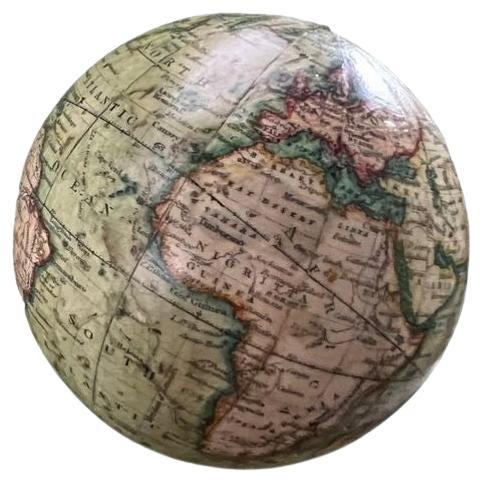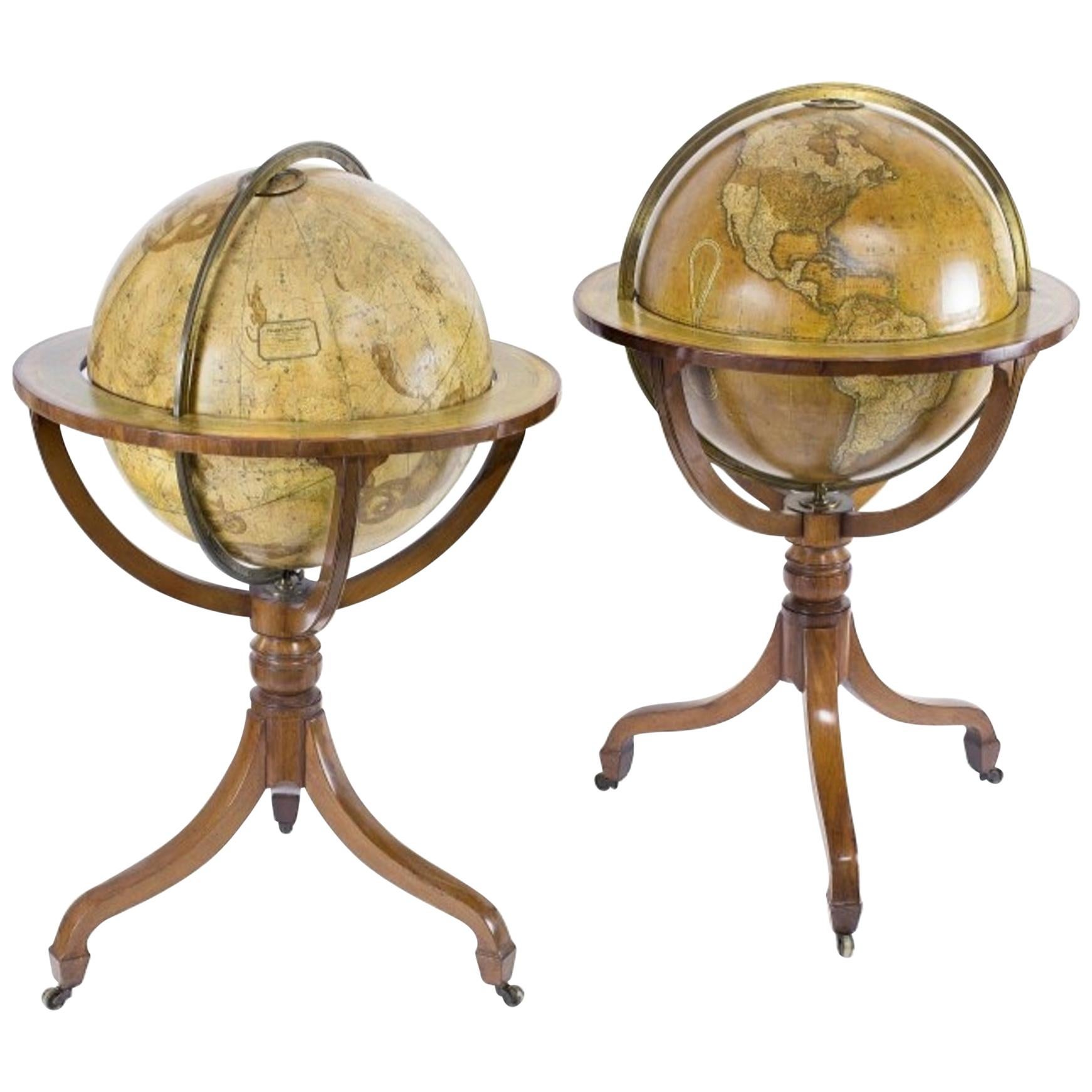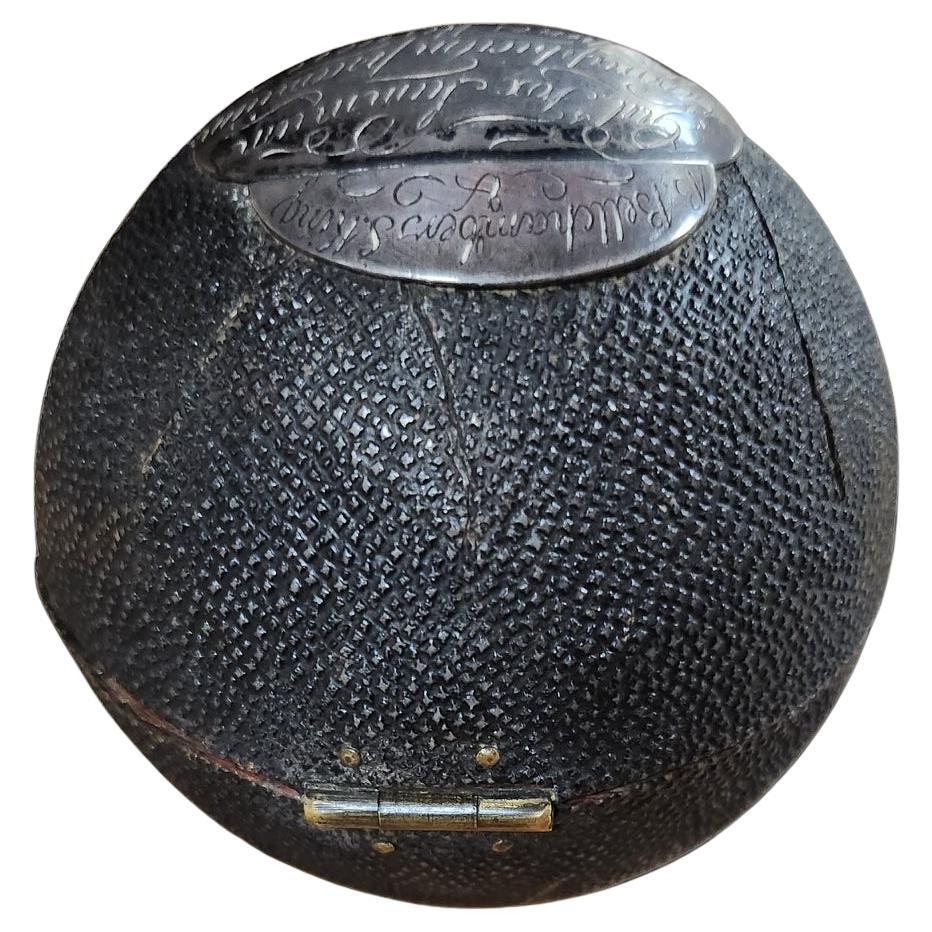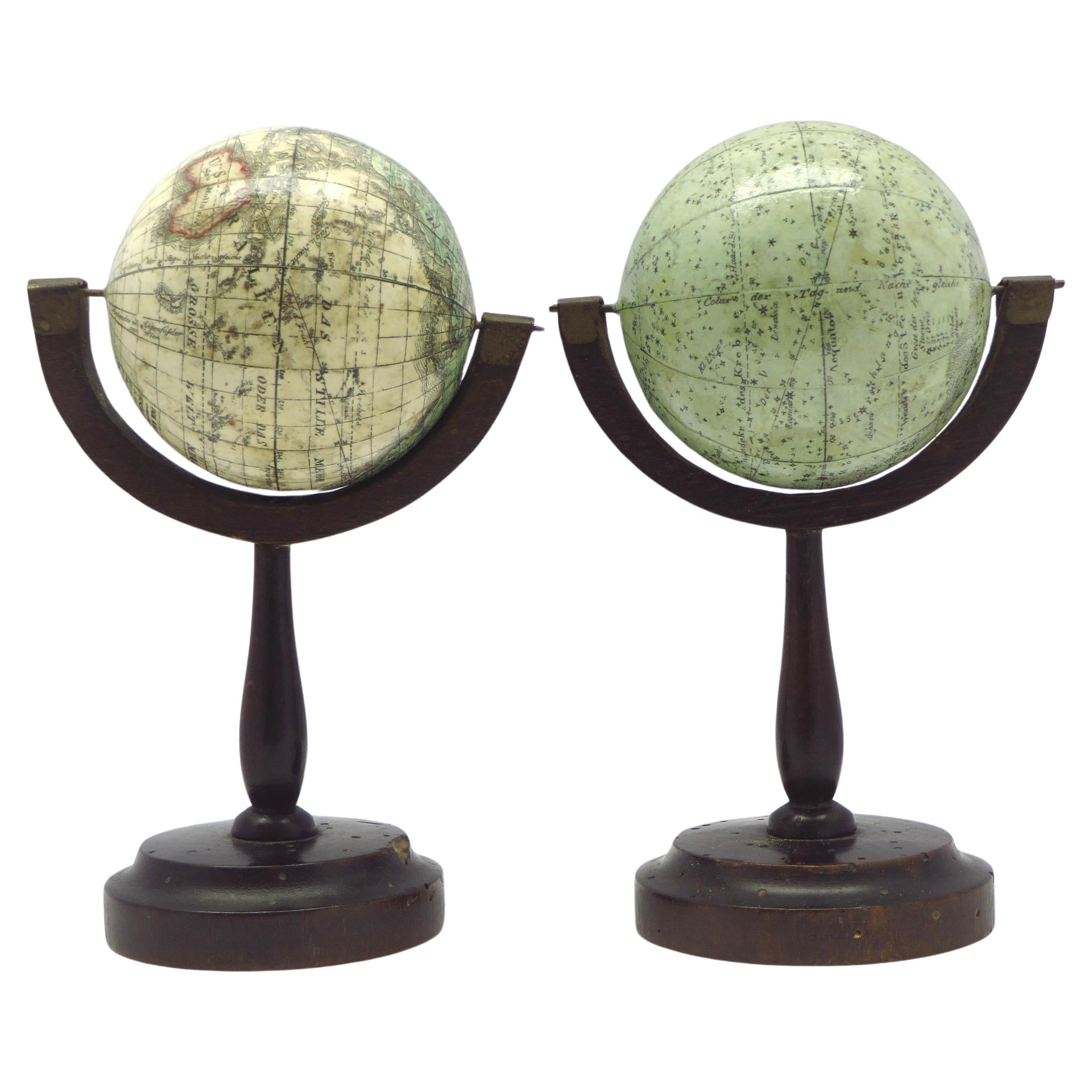Items Similar to Miniature globe in aturned and stained beech
Want more images or videos?
Request additional images or videos from the seller
1 of 17
Miniature globe in aturned and stained beech
About the Item
Newton & Son pocket globe
London, 1838
Miniature terrestrial globe with a diameter of 2 inches / 5 cm.
In a turned and stained beech two-section case, 3,95 inches / 10 cm. high.
- Creator:Newton and Son (Maker)
- Dimensions:Height: 3.95 in (10.04 cm)Diameter: 2 in (5.08 cm)
- Style:Late Victorian (Of the Period)
- Materials and Techniques:
- Place of Origin:
- Period:
- Date of Manufacture:1838
- Condition:Minor structural damages. With small damages to Africa, Asia, and Australia.
- Seller Location:ZWIJNDRECHT, NL
- Reference Number:1stDibs: LU9419239074652
About the Seller
New to 1stDibs
Joined in the past six months.
No Reviews Yet
Vetted Seller
These experienced sellers undergo a comprehensive evaluation by our team of in-house experts.
1stDibs seller since 2023
- ShippingRetrieving quote...Ships From: ZWIJNDRECHT, Netherlands
- Return PolicyA return for this item may be initiated within 14 days of delivery.
More From This SellerView All
- Miniature pocket globe in colourful card boxBy Michael ManningLocated in ZWIJNDRECHT, NLMiniature terrestrial pocket globe. Model of the earth. London, 1857 by J. Manning diameter of 1,75 inches / 4,5 cm. This lovely miniature terrestrial globe consists of twelve copp...Category
Antique 19th Century British Early Victorian Globes
MaterialsHardwood, Paper
- A truly delightful miniature terrestrial pocket globeBy Nathaniel MillsLocated in ZWIJNDRECHT, NLA truly delightful miniature terrestrial pocket globe in a celestial case, 3 inches / 6.8 cm. The globe consists of 12 wonderful varnished, engraved hand-coloured gores that stretch from pole to pole. In the original case of black fish-skin with a brass hinge and two brass hook-and-eyelet closures, case with a unique silver plaque which reads: "B. Bellchamber S. King - Gul's Fox Summum Geographicum Praemium Pares Meruere". * [This very roughly translates to:] "B. Bellchamber S. King - Gul's Fox Earns Top Geographical Peers Award". *Is it too much to suppose and speculate that this wonderful silver plaque attached to the outer case is in recognition of a [geographic?] scholastic achievement? The prize awarded to the lucky recipients (B. Bellchamber & S. King?) is this globe? This terrestrial globe has two repairs; to the area concerning the British Isles, and also to parts of Europe and Scandinavia (with some loss). There is some slight loss to a portion of North America, and there is a crack to the northern portion of South America. It is partly worn in other places and has some slight spotting. It is lacking the axis metal pin, and the two holes that normally allow for this pin have been closed. The case is split and segmented, partly rubbed and worn with cracks, (as is usual.) The case will close. There is some minor chipping and cracking to the outer rim of the inside of the case. About Pocket Globes. It is generally thought that Joseph Moxon brought pocket globes to England in the late seventeenth century. These globes usually consist of a terrestrial sphere of about 7.5 cm in diameter that fits into an outer case (usually made of fish-skin). The interior of this case often bears bright, colourful celestial cartography, so you effectively have the celestial heavens surrounding the terrestrial earth. Pocket globes, although highly desirable, are for all intents and purposes somewhat impractical, as their size makes accurate calculations impossible. Few, if any, pocket globes came with accompanying booklets, so it is hard for anyone to know who used them and for what purposes. Pocket globes could simply have served purely as status symbols for wealthy gentlemen, who had an interest in geography or astronomy. The fields of geography and the sciences were quickly advancing during this period. Alternatively, pocket globes could be seen as a tool used in children’s education, especially when you think that they are construction from cheap materials such as papier-mâché. Points of Interest. This particular globe shows California as a peninsula, whereas previously it had been depicted as an island – a misconception dating back to the sixteenth century; it has the northwest coast of America simply as "unknown parts."; - due to a profound lack of knowledge of the region; the track of Admiral George Anson’s circumnavigation of the world (1740-44) is drawn – Anson led a squadron of eight ships on a mission to disrupt or capture the Pacific Ocean possessions of the Spanish Empire, for emphases, the trade winds are indicated by red arrows. There are three large lakes engraved in Africa that may longer exist. The Celestial Gores. The celestial gores, housed within the case, are fun and eye-catching both in their display and in their content. Constellations and both hemispheres and are represented. Gemini, Cancer, Virgo, Orion, Andromeda, Taurus, Leo, Ursa Major etc in the north, and Scorpio, Libra, Canis Major etc in the south. A celestial globe is a mapping of the stars, and has been used since classical times. Celestial globes were first used by Greek astronomers, and later by the Islamic world, where the earliest known globes date from the eleventh century. The stars were thought to sit on the surface of a giant sphere around the earth, and the constant movement of the stars each night and throughout the year appeared to be caused by this giant sphere slowly turning overhead. In line with its counterpart, the terrestrial globe, celestial globes are mapped by a north and a south pole, an equator, and lines of latitude and longitude. The Terrestrial Globe. The North Pole encompasses the Arctic Circle, Baffin Bay (Canada), Iceland, Greenland, northern Siberia and Nuova Zembla. Europe shows the Dominion of Muscovy (a principality of the late Middle Ages centered on Moscow), Turkey, the British Isles, Italy etc. Africa highlights the Barbary coast, Biledulgerid (a former country in North Africa), the Zaara Desart (Sahara Desert), Negroland (an archaic term in European mapping referring to large portions of West Africa), Guinea, Ethiopia, Congo, the islands of the Azores and the Canaries. Australia (New Holland) shows the outdated cartography of an incomplete coastline; The West Australian and Northern Territory coastlines are in full, however, there is no connected mainland coastline from South Australia up to Northern Queensland. Papua New Guinea is still thought to be a part of the Australian mainland. A portion of Tasmania’s coastline is engraved. The only places/regions mentioned are: Dimens Land and Carpentaria in the north; Lewins, St. Francis, Mary’s Island, South Cape, and Dimens Land in the south. Interestingly, a place named Hartog’s Island is mentioned off the West Australian coast. This island has a unique place within Australia’s history as it is the first recorded European landing on Australian soil in 1616 by the island’s namesake, Dutch captain Dirk Hartog...Category
Antique Mid-18th Century British Dutch Colonial Globes
MaterialsOther
- A fine pair of miniature globes on standsBy Karl MullerLocated in ZWIJNDRECHT, NLA rare pair of miniature terrestrial and celestial globes. by K. Müller, 1822 Karlsruhe, Germany Diameter globes: 7 cm. Total high: 14,5 cm. Each with 12 hand-coloured engraved p...Category
Antique Early 19th Century German International Style Globes
MaterialsHardwood, Paper
- An extremely rare pair of miniature globes by Johann Baptist HomannBy Johann Baptist HomannLocated in ZWIJNDRECHT, NLJ.H. Homann (Germany, 1664-1724) Nürnberg, after 1715 Globus Terrestris [and] Globus Celestis. juxtu observationes Parisienses Regia Academia Scientiarum constructus [and] juxtu observationes Parisienses Regia Academia Scientiarum constructus. Nuremberg, [after 1715]. Original stands by Homann Heirs, [after 1730]. An extremely rare pair of terrestrial and celestial globes, each with 12 hand-coloured engraved paper gores, over a papier mâché and plaster sphere, each globe with papier mâché meridian ring, mounted on horizon rings with a handwritten number VIII and III on each globe. The horizon rings supported by four quadrants with text "Zu finden in Nürnberg / wohnhaft unter der Vesten / bey denen Homaenischen Erben/ dem Prediger Klöster gegenüber", both globes on a turned single wooden black stand. Diameter 64 mm (2.5 inches), height 185 mm. RARE. Johann Baptist Homann (1664–1724), a German geographer and cartographer. He founded a publishing business in Nürnberg in 1702, and published his first atlas in 1707, becoming a member of the Academy of Sciences in Berlin in the same year. Homann was appointed Imperial Geographer to Charles VI in 1715 and became the most important map...Category
Antique 1710s German Dutch Colonial Globes
MaterialsOther
- A decorative pair of rare table globes in a fine condition.By Johann Gabriel DoppelmayrLocated in ZWIJNDRECHT, NLThese pair of globes, dated 1730, are original and in fine condition. Title: Globus terrestris novus Loca Terrae insigniora sec. praestant Astron. et Geogr. observationes sistens op...Category
Antique Early 18th Century German Baroque Globes
MaterialsOther
- A huge pair of 21 inches Cruchley Library GlobesBy G.F. CruchleyLocated in ZWIJNDRECHT, NLG.F. Cruchley (UK, 1796-1880) London ca 1850 A magnificent pair of terrestrial and celestial globes. Equatorial table engraved with the signs of the zodiac and resting on 3 mahogany molded feet held by a compass at the spacer. With graduated brass meridian circles and time clocks. The terrestrial globe is inscribed in a cartouche: Cruchley's new terrestrial globe from the most recent and best authorities. Exhibiting the discoveries in equatorial Africa, north pole. And the new settlements and divisions in Australia, New Zealand, Californa, Texas, &c. London. Sold by Gould and Porter opticians 181 strand WC. The celestial globe is inscribed in a cartouche: Cruchleys new celestial globe on which is accurately laid down the whole of the stars and nebule contained in the astronomical catalogue of the Reverend Mr. Wollaston F.R.S. Also from the authorities Flamstead, De La Caille, Hevellus, Bradley, Herschel, Maskelyne, &c. Ands the limits of each constellation determined by a boundary line. London, published by G.F. Cruchley, map-seller & globe maker, 81 Fleet street. Signed: CRUCHLEY in London England, circa 1850 H. 125 cm Diam. 53 cm (21 inches) Diam. 25 cm compasses The two spheres are in a perfect state of freshness and are perfectly legible. The condition of both the globes is very good. There have been some professional repairs to some damaged gores. The Terrestrial globe in good conserved and legible condition, it has areas of rubbing, retouching, and slight discoloration. The Celestial globe is also in good conserved and legible condition with areas of rubbing, retouching and slight discoloration. The gores themselves have been cleaned and revarnished. The splendid mahogany legs and moulded feet are in first class condition. Each globe consists of 12 hand coloured copper engraved gores over a paper-maché hollow core, made up of two hemispheres joined at the equator and covered with a layer of plaster. There are paper horizon rings, made up of a series of concentric circles, displaying the months of the year, the signs of the zodiac and wind directions. THE TERRESTRIAL GLOBE. The globe provides much detailed information, and was accurate up to the date of production, which in this case is the mid-19th century. It shows the latest discoveries and developments that had taken place. It displays names and territories that were once familiar to the people of the age, 150 years into the future! In Asia for example, there are places like ‘Little Bucharia’, ‘Little and Greater Tartary’, ‘Russia in Asia.’ Undoubtedly, the continent that has changed more than any other is Africa. So many African countries that we know and recognise now, had different, perhaps more ‘Colonial’ names more than a century and a half ago. There was ‘Nubia’ (Sudan/Egypt), ‘Abbyssinia’ (Ethiopia), ‘Cape Colony’ (South Africa), ‘Dahomey’ (Benin) but to name a few. Australia was a little over 50 years away from its union via ‘Federation’ in 1901. This brought about the Commonwealth of Australia. However, in 1850 they were six separate British selfserving colonies, ruled directly from England. In North America, both Los Angeles and San Francisco are incorporated as cities into California - as it becomes the 31st U.S. state. Much of mid-western and western USA were known as ‘The Western Territory’ & ‘The Missouri Territory’, Florida was still refered to as ‘East & West Florida’. Canada was split into ‘Canada East’ & ‘Canada West.’ Canada East was primarily (for historical reasons) French-speaking, and Canada West primarily Englishspeaking. Much of Western Canada remained unexplored and undeveloped. In Europe, there was still the ‘Russian Empire’, the ‘Ottoman Empire’, the ‘AustroHungarian Empire’, and the German ‘Prussian Empire.’ THE CELESTIAL GLOBE. The Celestial Globe displays the stars, the constellations, clusters and nebulae in a beautiful and well thought out manner. Mythical figures and signs of the zodiac are seen. The equinoctial and solistitial colures are graduated in degrees. Although the colour is somewhat muted, it takes nothing away from the overall beauty and the undoubted aesthetic qualities of the globe. Historically, globes are among the most ancient scientific instruments known to man. They can be dated back over two millennia, and are still manufactured to this day. The earliest tradition of globe making is mainly concerned with celestial globes – man...Category
Antique 1850s British Victorian Globes
MaterialsOther
You May Also Like
- Newton and Son Pocket Globe and CaseBy Newton and SonLocated in Spencertown, NYThe terrestrial globe is 3 inches in diameter contained within a turned mahogany box with cover. The seas in light green and land masses in darker green. Dimension of Globe 3" Diame...Category
Antique Mid-19th Century English Victorian Globes
MaterialsFruitwood, Paper
- Newton & Sons Late George III Terrestrial and Celestial Mahogany Library GlobesBy Newton and SonLocated in West Palm Beach, FLFine pair of Newton & Sons late George III 20 inch terrestrial and celestial tripod mahogany library globes, London, second quarter of the 19th century, the terrestrial globe, dated...Category
Antique 1830s Globes
MaterialsWood
- 19th Century German Miniature Pocket Terrestrial GlobeBy C. Abel-KlingerLocated in Essex, MAA miniature 19th century 3.5 inch diameter pocket terrestrial globe by C. Abel-Klinger, Nuremberg, Germany, in English for the English speaking markets. Signed with cartouche reading...Category
Antique 1880s German Scientific Instruments
MaterialsBrass
- 19th Century French Table Globe / "Globe Terrestre" by J. Forest / ParisLocated in Dallas, TXA well proportioned paper, plaster terrestrial globe standing on a turned ebonized base. GLOBE TERRESTRE "Dressé par J. FOREST GÉOGRAPHE EN VENTE A PARIS Chez l'Auteur 17 Rue de ...Category
Antique Late 19th Century French Late Victorian Globes
MaterialsPlaster, Paper
- Antique 19th Century Miniature French Edition Globe by C. Abel-KlingerBy C. Abel-KlingerLocated in Philadelphia, PAA fine antique French Edition miniature globe. By C. Abel-Klinger. On a turned wooden stand with an uncalibrated brass half meridian. The globe is marked with an integral l...Category
Antique 19th Century German Neoclassical Maps
MaterialsPaper
- Midcentury Waste Bin in Beech and Cane, Made in Denmark, 1950sBy Frits HenningsenLocated in Lejre, DKWaste bin in beech and cane, design and made attributed to Cabinetmaker Frits Henningsen. Great original condition. Made in Denmark, 1950s.Category
Vintage 1950s Danish Mid-Century Modern Home Accents
MaterialsCane, Beech





